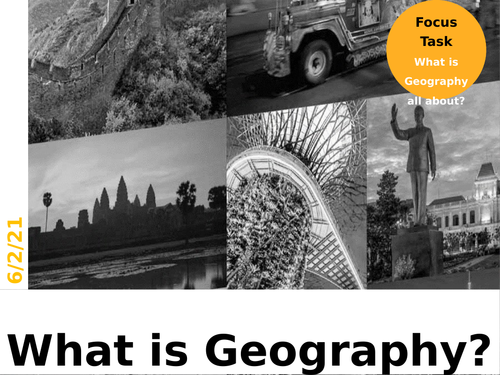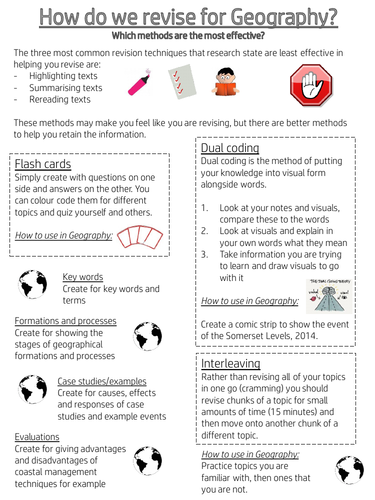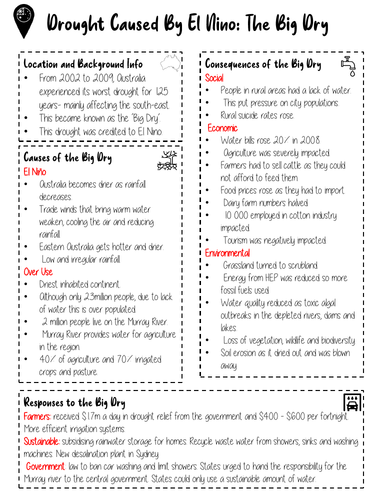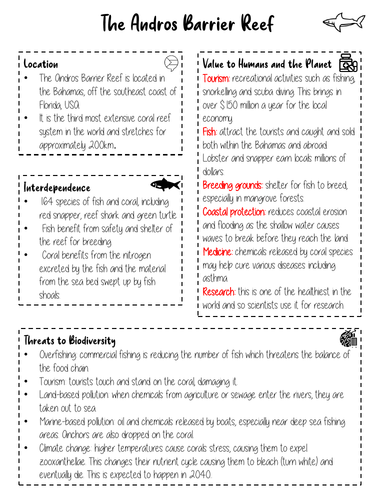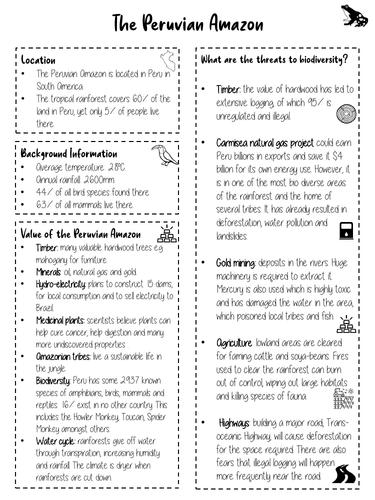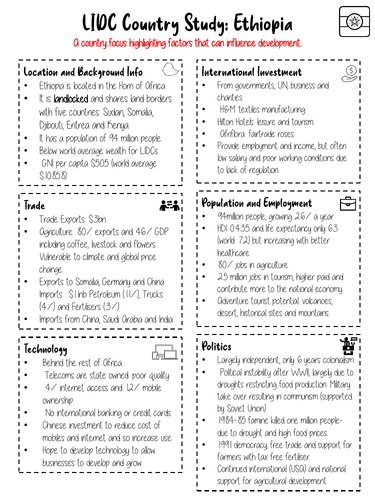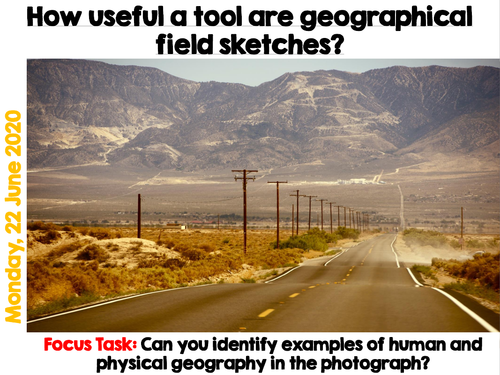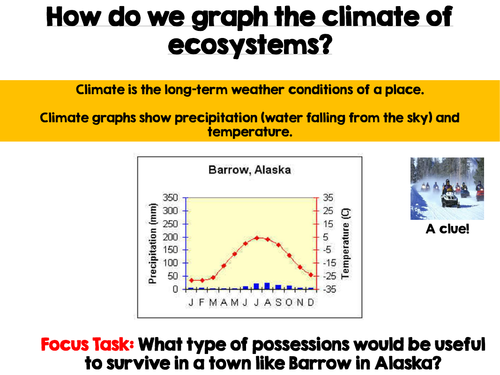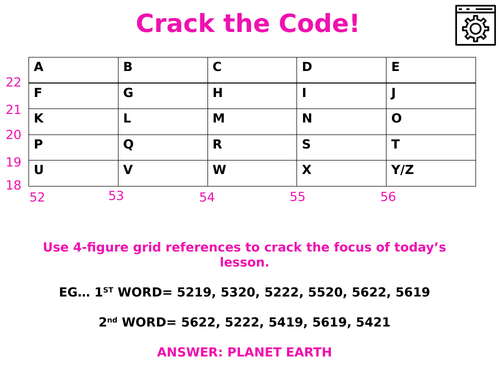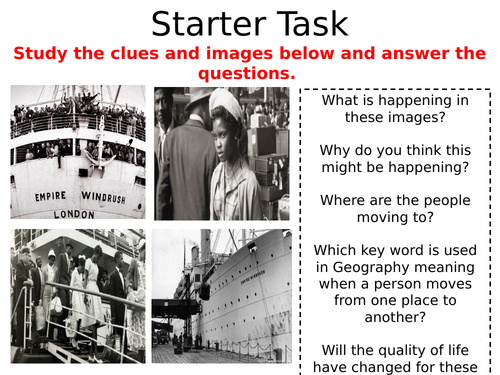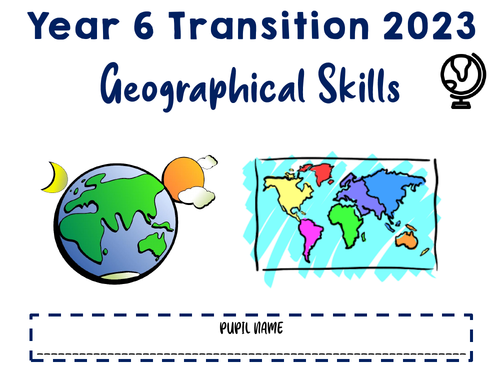38Uploads
15k+Views
30k+Downloads
All resources

National Windrush Day Assembly 2023
Tuesday 22nd June 2023 is the 6th National Windrush Day. This assembly has been created to highlight the importance of the Windrush generation, showing the journey as well as background information.
Videos have been embedded to support understanding as well as audio.
Bundle Sale

KS3 Schemes of Work/Learning Bundle
A bundle of some of my schemes of work to save you some cash! Included is:
KS3 Asia SOW
KS3 Afroca SOW
KS3 River Landscapes SOW
KS3 Using our Natural Environment SOW
KS3 Population SOW
Bundle Sale

Knowledge Organiser Bundle
A bundle of knowledge organisers as part as OCR A 9-1 GCSE Geography Paper 1/2. It includes:
Andros Barrier Reef
Ethiopia- a country study
Peruvian Amazon
Rio de Janeiro- a study of a city in a EDC
The Big Dry- drought case study

What is Geography?
A fully editable lesson introducing students into what is Geography?
The lesson includes:
Circle map task
Defintions
Categorising types of Geography
Plenary- categorising elements of Geography through images

How do we revise for Geography?
A useful resource to support students in finding suitable ways for them to prepare and revise in Geography.

Student Friendly Command Words
Student friendly commands words for OCR A GCSE Geography.
I have this in my exercise books and as a display as a constant reminder.
Sale

The Big Dry Knowledge Organiser
A detailed but compact knowledge organiser based upon the case study of the Big Dry in Australia.
This organiser includes:
Location
Background Information
Causes
Effects/Consequences
Responses
Sale

Andros Barrier Reef Knowledge Organiser
A compact but detailed knowledge organiser based upon the case study of the Andros Barrier Reef. This organiser includes:
Location
Background Information
Value
Threats
Management
Sale

Peruvian Amazon Knowledge Organiser
A compact but detailed knowledge organiser designed for OCR A/equivalent to provide information on the case study of the Peruvian Amazon. This organiser includes:
Location
Background Information
Value
Threats- gas, mining, agriculture and highways
Management- Purus Manu Corridor
Sale

Ethiopia Knowledge Organiser
A knowledge organiser for Ethiopia based upon the study of a LIDC. Perfectly suited to OCR A/AQA equivalent GCSE specifications and designed to be compact for student memory. The organiser includes:
Location
Background Info
Trade
Technology
International Investment
Population
Politics
Environment
Aid (Goat Aid)
Social factors
Sale

Rio de Janeiro Knowledge Organiser
A knowledge organiser for Rio de Janeiro including:
Location
Background info
Importance
Why Rio has grown
What is Rio like?
How has migration changed Rio?
Challenges of housing, traffic and waste (including statistics and place specific info)
Favela Bairro Project
This would perfectly suit OCR A GCSE 9-1 or the AQA equivalent.

Field Sketches
Free and fully editable lesson showing students what field sketches are, the top tips for drawing field sketches, practice examples and +/- of field sketches.

Climate Graphs
Free and fully editable lesson based around skills required for climate graph interpretation.
The lesson includes:
How is a climate graph made and interpreted?
Guess Who! (climate graph edition…)
Constructing own climate graph using data
+/- of climate graphs

Starter Toolkit
This is a starter toolkit designed and made to engage students from the start of the lesson. This fully editable download includes:
Crack the code
Hangman
What if?
The 5 W’s
What can you sense?
Word scramble
Word association
Odd one out
Think, pair, share
Three golden rules
Brain fill
Spot the difference
Circle time
What’s the link?
Geog your memory
What do you know?
What’s your opinion?
Bingo
Which is the worst?
Disclaimer- ‘KG Second Chances Sketch’ is the font used.

Structure Sheets
A range of different structure sheets designed and made to support students in answering higher tariff exam questions at GCSE, and a challenge in KS3.
These sheets are fully editable. This download includes:
To what extent
Assess
Evaluate
How far do you agree?
The four mark explain
Describe
Discuss
Disclaimer note- ‘The Skinny’ and ‘Sweet Purple’ are the fonts used.

National Windrush Day 2021
A fully editable lesson created for National Windrush Day 2021 (Tuesday 22nd June) to highlight the importance of migration patterns to the UK in the past and to inform students of the event.
The lesson includes:
Photo interpretation tasks
Key word match ups
Map work based upon the journey
Geographical skills questions
Development indicators based upon Jamaica
Push and pull factors
Disclaimer- Please don’t adapt and then re-share without my permission.

Year 6 Transition Work 2023- Geography
I have created a Geography transition work book for Year 6 students to complete to aid the transition to secondary school. This will support students with the key skills needed to progress.
Sale

River Landscapes KS3 SOW
This scheme of work is aimed at KS3 and based around river landscapes. This scheme of work includes the following:
How does the hydrological cycle work?
What are the key terms and processes associated?
What is the hydrological cycle and how does it work?
Include: key terms of precipitation, condensation, ground-water flow, surface-water flow, evaporation, impermeable and permeable rock.
What are the different kinds of geomorphological processes?
Processes of erosion- hydraulic action, abrasion, attrition and solution
Processes of weathering- biological, chemical and mechanical (freeze thaw)
Processes of mass movement- slumping and sliding
Processes of transportation- traction, saltation, suspension and solution
What are the long and cross profiles of a river?
Pupils need to recognise the different shapes for both the long and cross profile diagrams of a river valley.
Identify the difference between the upper, middle and lower courses of a river including the valley shape and river channel.
How do geomorphological processes lead to the formation of river landforms?
The formation of river landforms (waterfall, gorge, V-shaped valley, floodplain, levee, meander, oxbow lake)
Case Study: River Tees Location of The River Tees
Key features found in the upper, middle and lower course.
Human activities found along the upper course of The River Tees (sheep farming, Cow Green Reservoir and tourism in Middleton) and the impact that this has had on the landscapes.
Human activities found along the lower course of The River Tees (Tees Barrage and meander straightening) and the impact that this has had on the landscapes.
Sale

Asia KS3 Scheme of Work
This is a complete KS3 scheme of work of 13 lessons focusing upon the continent of Asia. The scheme of work includes the following:
Asia is a wealthy continent. How far do you agree?
Locating Asia – map work (pupils need to learn the names and location of the continents as well as the names and location of countries within Asia)
Contrasting images of Asia to be given to pupils to instigate a discussion about the wealth of the continent.
Pupils answer the key question using the photographs and discussion as evidence.
GDP/GNI map of Asia and any commonly used measure of development.
Case Study: Japan
Location of Japan and the four major islands- map work
Japanese climate and physical features
Introduction- what is Japan like and how has it changed?
Japanese ecosystems- concentrate on one of: coniferous or deciduous woodland + flora and fauna adaptations.
Japanese industry- imports and exports (pie chart/bar chart must be used)
Population structure of Japan- ageing population and population pyramids
Should tourism in Asia be encouraged? Case Study: Thailand
Introduce tourism in an Asian country (Thailand)
Look at the changing number of tourists visiting the country (graph interpretation) – are there reasons that explain the fluctuating number? e.g.
Asian tsunami 2004
Pupils need to investigate the pros and cons of tourism and then be able to justify their decision as to whether they think tourism should be encouraged or not?
What are the characteristics of tropical rainforests?
Describe the distribution of tropical rainforests around the world
Understand the that the rainforests grow in layers (shrub layer, under canopy, canopy and emergent) and the reasons for this
Pupils need to be aware that animals and plants have adapted to life in the rainforest and have different characteristics depending on the layer they live in.
Do we need to protect tropical rainforests?
Pupils need to understand the importance of tropical rainforests to both humans and the environment
The causes of the destruction of the rainforests needs to be investigated both the human and natural causes
Pupils need to be able to link together the causes of the destruction and the consequences this has.
Sale

Population KS3 Scheme of Learning
This is a fully resourced 9 lesson scheme of learning based on the module of population and aimed at KS3. The scheme of learning includes:
Lesson 1: Why is the world’s population distribution uneven?
Lesson 2: Why is overpopulation a challenge?
Lesson 3: What factors influence population growth?
Lesson 4: How does the Demographic Transition Model show population change?
Lesson 5: How can we study the population structure of a country?
Lesson 6: What are the challenges and opportunities created by an ageing population?
Lesson 7: What are the challenges and opportunities created by immigration?
Lesson 8: What are the challenges created by rural-urban migration?
Lesson 9: Should refugees be allowed access to the UK?




